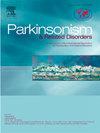Mitochondrial and autophagic dysfunctions of skin fibroblasts derived from pantothenate kinase-associated neurodegeneration patients carrying PANK2 mutations and the rescuing effects of allantoin
IF 3.1
3区 医学
Q2 CLINICAL NEUROLOGY
引用次数: 0
Abstract
Introduction
Pantothenate kinase-associated neurodegeneration (PKAN) is a rare neurodegenerative disorder marked by brain iron accumulation and mitochondrial dysfunction, with limited effective treatments. This study investigates cellular dysfunctions in PKAN fibroblasts with PANK2 mutations and evaluates the therapeutic potential of the antioxidant allantoin for protecting mitochondrial and autophagic functions.
Methods
We investigated oxidative stress, mitochondrial impairment, and autophagic dysfunction in skin fibroblasts derived from PKAN patients carrying mutations in the PANK2 gene and siR-pank2 treated fibroblasts, and evaluates the therapeutic potential of allantoin in mitigating these defects.
Results
Our results revealed significantly elevated levels of H2O2 and an increased mitochondrial labile iron pool (LIP), also reduced aconitase 2 (ACO2) activity and mitochondrial membrane potential, suggesting heightened oxidative stress and mitochondrial dysfunction. Autophagic flux was also impaired, as evidenced by the increased LC3-II and p62 accumulation. Allantoin treatment significantly reduced intracellular iron deposition and lipid peroxidation in PANK2-deficient fibroblasts. LIP levels were decreased, and ACO2 activity was elevated in allantoin-treated PANK2 mutant fibroblasts and siRNA-pank2 fibroblasts. Additionally, allantoin treatment promoted autophagic flux by reducing LC3-II and p62 levels.
Conclusion
These findings highlight the key pathological effect of oxidative stress, mitochondrial dysfunction and impaired autophagy in PKAN and suggest a protective role of allantoin in iron deposition via dual regulation of mitochondrial dysfunction and compromised autophagy. The data provides a foundation for future in vivo studies and the potential clinical application of allantoin in PKAN and related neurodegenerative diseases.
求助全文
约1分钟内获得全文
求助全文
来源期刊

Parkinsonism & related disorders
医学-临床神经学
CiteScore
6.20
自引率
4.90%
发文量
292
审稿时长
39 days
期刊介绍:
Parkinsonism & Related Disorders publishes the results of basic and clinical research contributing to the understanding, diagnosis and treatment of all neurodegenerative syndromes in which Parkinsonism, Essential Tremor or related movement disorders may be a feature. Regular features will include: Review Articles, Point of View articles, Full-length Articles, Short Communications, Case Reports and Letter to the Editor.
 求助内容:
求助内容: 应助结果提醒方式:
应助结果提醒方式:


